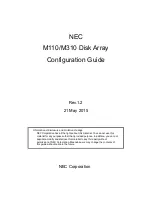
1.
In
Prefix
, type the characters that will become the fixed characters for the beginning of
the LDEV name. The characters are case-sensitive.
2.
In
Initial Number
, type the initial number that will follow the prefix name.
11. In
Format Type
, select the format type for the LDEV from the list.
•
For an internal volume, select
Normal Format
,
Quick Format
, or
No Format
.
If
No Format
is selected, format the volume after creating LDEVs.
•
For an external volume, if you create the LDEV whose emulation type is the open system,
select
Normal Format
or
No Format
.
If the external volume can be used as it is, select
No Format
. The created LDEV can be
used without formatting.
If the external volume needs to be formatted, select
No Format
then format the volume
with the external storage system, or select
Normal Format
.
•
If
Quick Format
is selected while quick formatting is in progress, host I/Os may be affected.
For details, see
“Quick Format function” (page 58)
.
12. Click
Options
to show more options.
13. In
Initial LDEV ID
, make sure that an LDEV ID is set. To confirm the used number and unavailable
number, click
View LDEV IDs
to open the
View LDEV IDs
window.
1.
In
Initial LDEV ID
in the
Create LDEVs
window, click
View LDEV IDs
.
In the
View LDEV IDs
window, the matrix vertical scale represents the second-to-last digit
of the LDEV number, and the horizontal scale represents the last digit of the LDEV number.
The
LDEV IDs
table shows the available, used, and disabled LDEV IDs.
In the table, used LDEV numbers appear in blue, unavailable numbers appear in gray,
and unused numbers appear in white. LDEV numbers that are unavailable may be already
in use, or already assigned to another emulation group (group by 32 LDEV numbers).
2.
Click
Close
.
14. In the
Create LDEVs
window, in
SSID
, type four digits, in hexadecimal format (0004 to FEFF),
for the SSID.
15. To confirm the created SSID, click
View SSIDs
to open the
View SSIDs
dialog box.
1.
In the
Create LDEVs
window, in
Initial SSID
, click
View SSIDs
.
In the
SSIDs
window, the
SSIDs
table shows the used SSIDs.
2.
Click
Close
.
16. In the
Create LDEVs
window, from the
MP Blade
list, select a MP blade to be used by the
LDEVs.
•
If you assign a specific MP blade, select the ID of the MP blade.
•
If you can assign any MP blade, click
Auto
.
17. Click
Add
.
The created LDEVs are added to the
Selected LDEVs
table.
The
Provisioning Type
,
System Type
,
Emulation Type
,
Parity Group Selection
,
LDEV Capacity
,
and
Number of LDEVs per Free Space
or
Number of LDEVs per External Volume
fields must
be set. If these required items are not registered, you cannot click
Add
.
18. If necessary, change the following LDEV settings:
•
Click
Edit SSIDs
to open the
SSIDs
window. If the new LDEV is to be created in the CU,
change SSID to be allocated to the LDEV. For details about how to edit an SSID, see
“Editing an LDEV SSID ” (page 53)
•
Click
Change LDEV Settings
to open the
Change LDEV Settings
window. For details about
how to change the LDEV settings, see
“Changing LDEV settings” (page 54)
.
52
Configuring custom-sized provisioning
















































